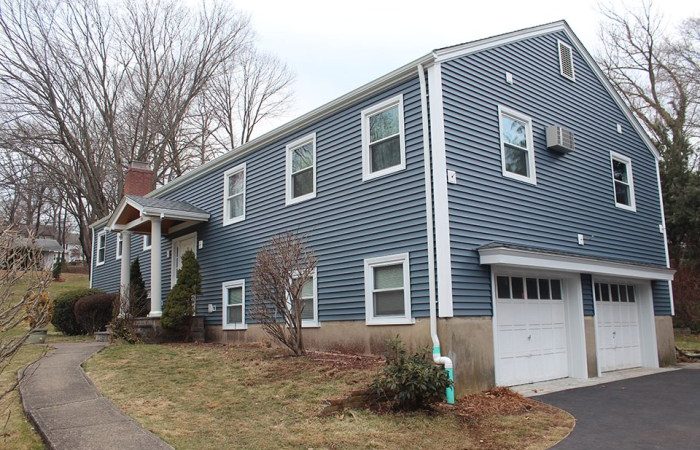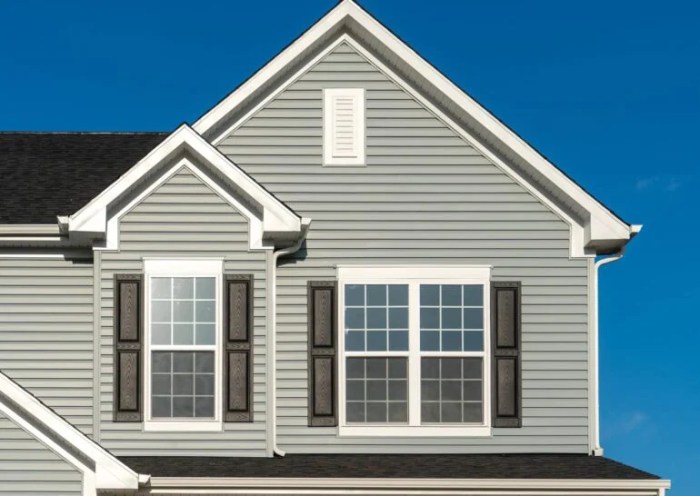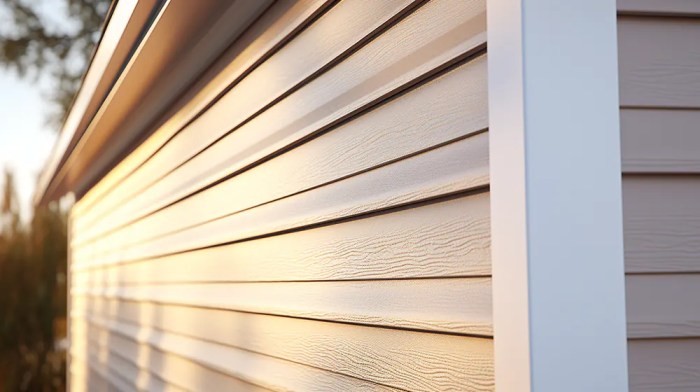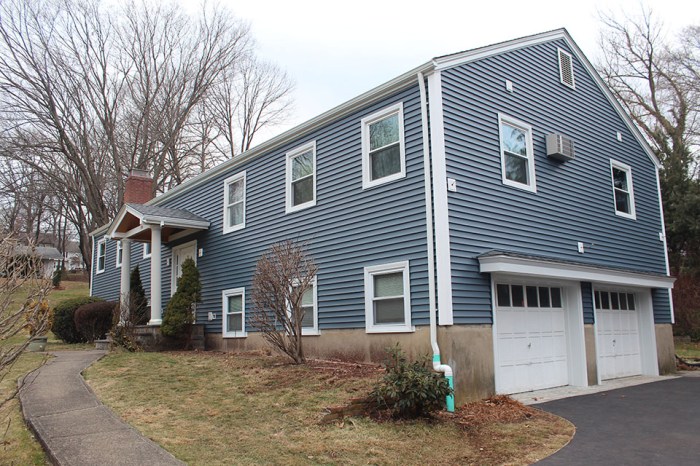How Much Does It Cost to Change Vinyl Siding?

How much does it cost to change vinyl siding? That’s a question many homeowners ask, and the answer isn’t a simple number. The total cost depends on several factors, from your home’s size and the type of siding you choose to your location and the contractor you hire. We’ll break down all the key cost drivers, helping you understand what influences the final price tag and how to get the best value for your money. We’ll explore materials, labor, and even the potential savings (or added costs) of DIY versus professional installation.
This guide will walk you through the process of estimating the cost of your vinyl siding replacement. We’ll look at different vinyl siding types, brand comparisons, labor costs across various regions, and the added expenses of things like trim and removal of old siding. Understanding these elements will empower you to make informed decisions and budget effectively for your project.
Factors Affecting Vinyl Siding Replacement Cost
Replacing your vinyl siding is a significant home improvement project, and the total cost can vary widely. Several key factors influence the final price, from the size of your house to the complexity of the installation. Understanding these factors will help you budget effectively and avoid unexpected expenses.
House Size
The size of your house is a primary determinant of the overall cost. Larger homes naturally require more siding materials and more labor hours, leading to a higher total expense. For example, a 1,500 square foot house will cost considerably less than a 4,000 square foot home. It’s essential to obtain accurate measurements of your home’s exterior surface area to get a precise estimate. This includes calculating the area of walls, gables, and any other surfaces covered by siding.
Vinyl Siding Type
The type of vinyl siding you choose significantly impacts the cost. Higher-quality siding, often thicker and more durable, is more expensive than basic options. Styles also affect pricing; intricate designs and textures generally cost more than simpler, smooth profiles. For instance, premium vinyl siding with a cedar shake or stone look will typically command a higher price per square foot compared to standard lap siding. Thickness also plays a crucial role; thicker siding usually means better insulation and durability but at a higher initial cost.
Labor Costs by Geographic Location
Labor costs vary significantly depending on your geographic location. Areas with a higher cost of living and strong demand for skilled labor will naturally have higher labor rates for siding installation. Metropolitan areas tend to have higher labor costs than rural regions. For example, a siding installation project in New York City might cost considerably more than the same project in a smaller town in the Midwest. This is due to factors such as higher wages for contractors and the higher cost of operating a business in more expensive locations.
Costs Associated with Old Siding Removal
Removing old siding adds to the overall project cost. The condition of the existing siding and the presence of underlying issues (like damaged sheathing) will affect removal time and expense. If the old siding is in poor condition and difficult to remove, or if significant repairs to the underlying wall are needed, the removal cost can be substantial. For example, if asbestos siding is present, specialized removal and disposal procedures are required, significantly increasing the overall cost.
Project Complexity
The complexity of the project significantly impacts the final cost. Intricate trim work, multiple architectural details, and the need for custom-fabricated pieces increase both material and labor costs. Homes with many dormers, bay windows, or complex angles will require more time and expertise, resulting in a higher price tag. A simple rectangular house with minimal trim will be much cheaper to build than a Victorian home with elaborate detailing.
Example Costs
| Siding Type | Material Cost (per sq ft) | Labor Cost (per sq ft) | Total Estimated Cost (per sq ft) |
|---|---|---|---|
| Basic Vinyl Lap Siding | $1.50 | $3.00 | $4.50 |
| Premium Vinyl Shake Siding | $3.00 | $4.00 | $7.00 |
| High-End Vinyl with Stone Texture | $4.50 | $5.00 | $9.50 |
Material Costs

Source: protoolreviews.com
Understanding the material costs involved in vinyl siding replacement is crucial for accurate budgeting. Prices vary significantly depending on several factors, including brand, type, color, and the need for accessories. Let’s break down the key cost drivers.
Vinyl Siding Brand Comparison
Different manufacturers offer vinyl siding with varying qualities and price points. Established brands often command higher prices due to their reputation for durability and performance, while lesser-known brands may offer more budget-friendly options, but potentially with shorter warranties or less robust performance. For example, CertainTeed and James Hardie are generally considered premium brands, resulting in higher costs per square foot compared to less-expensive options. The price difference can be substantial, sometimes exceeding $1 per square foot. This price difference reflects variations in material quality, manufacturing processes, and the associated warranties.
Solid vs. Hollow Vinyl Siding
Solid vinyl siding generally costs more than hollow vinyl siding. This is because solid vinyl is thicker and more durable, offering better resistance to damage from impacts and extreme weather conditions. The added thickness and density contribute to a higher price per square foot. While hollow vinyl siding might seem like a cost-effective choice initially, its lower durability may lead to more frequent repairs or premature replacement, negating any initial savings in the long run. A good rule of thumb is to consider the long-term value proposition, weighing the initial cost difference against the potential for longer lifespan and reduced maintenance.
Vinyl Siding Colors and Finishes
The color and finish of your vinyl siding can also influence the overall cost. Popular colors are generally more readily available, keeping prices competitive. However, more unique or custom colors might require special ordering, potentially increasing the price. Similarly, textured finishes, such as wood grain or stone patterns, tend to be slightly more expensive than smooth finishes. These added aesthetic features often come with a premium, reflecting the additional manufacturing processes involved. For instance, a deep, richly colored siding might cost 10-15% more than a standard white or beige option.
Pricing of Vinyl Siding Accessories
Accessories such as trim, flashing, and soffit are essential components of any vinyl siding installation. These items add to the overall project cost, and their pricing can vary depending on the material and style. High-quality, durable trim pieces will generally cost more than basic options. Flashing, crucial for water protection around windows and doors, also contributes to the overall expense. Soffit, the underside of the eaves, is another area where material choices influence cost. The cost of these accessories should be factored into your budget, as they represent a significant portion of the total expense beyond the siding itself.
Cost Per Square Foot Comparison
| Vinyl Siding Type | Cost per Square Foot (USD) |
|---|---|
| Budget-Friendly Hollow Vinyl (Basic Colors) | $2.00 – $3.50 |
| Mid-Range Solid Vinyl (Standard Colors) | $3.50 – $5.00 |
| Premium Solid Vinyl (Specialty Colors/Finishes) | $5.00 – $7.00+ |
| Premium Brand Solid Vinyl (Specialty Colors/Finishes) | $7.00+ |
Labor Costs and Contractor Selection

Source: protoolreviews.com
Replacing your vinyl siding involves significant labor costs, often exceeding material expenses. Understanding these costs and choosing the right contractor is crucial for a successful and budget-friendly project. This section will break down labor costs, contractor selection, and potential hidden expenses.
Labor costs for vinyl siding installation typically depend on several factors, making it hard to give a single definitive number. However, understanding these factors will help you navigate the process effectively.
Hourly Rates of Experienced Siding Installers
Experienced siding installers typically command hourly rates ranging from $40 to $80, sometimes even higher depending on location and demand. This hourly rate doesn’t include overhead, profit margins, or the cost of materials. Factors like the installer’s experience, reputation, and the complexity of the job significantly influence their rates. A highly skilled installer with a proven track record might charge at the higher end of this range, especially in areas with high construction costs.
Factors Influencing Overall Labor Costs
Several factors impact the overall labor costs beyond the hourly rate. The size of your home, the complexity of the installation (e.g., removal of old siding, intricate trim work), and the accessibility of your home all contribute to the final price. A larger home with multiple stories and difficult-to-reach areas will naturally require more labor hours, driving up the total cost. Similarly, extensive prep work, such as removing old siding or addressing underlying issues like rotted wood, adds to the overall labor expense. The geographical location also plays a role, with higher labor costs in areas with a higher cost of living.
Pricing Differences: Single Contractor vs. Larger Company
Hiring a single contractor or a larger company can affect pricing in different ways. Smaller, independent contractors may offer more competitive hourly rates, but might lack the resources and insurance coverage of larger companies. Larger companies often have higher overhead costs, resulting in potentially higher labor charges. However, they may offer more comprehensive services, warranties, and streamlined project management. The best choice depends on your individual needs and priorities. Weigh the potential cost savings against the potential risks and benefits of each option.
Questions to Ask Potential Contractors
Before committing to a contractor, asking specific questions is vital to compare pricing and services accurately. This ensures you understand exactly what you’re paying for and avoid unexpected costs.
- What is your hourly rate, and what does that include?
- Provide a detailed breakdown of labor costs for this project.
- What is your experience with vinyl siding installation, and can you provide references?
- What is your process for handling unforeseen issues during installation?
- What type of warranty do you offer on your labor?
- What is your insurance coverage, and can you provide proof of it?
- What is your payment schedule?
Potential Hidden Labor Costs
While the contractor should provide a comprehensive estimate, several hidden labor costs might arise. These could include unexpected demolition or repair work if underlying issues (like rotted wood or damaged sheathing) are discovered during the installation process. Additional labor might be needed for complex trim work, difficult access points (such as steep roofs or narrow spaces), or unforeseen delays due to weather conditions. Proper communication with your contractor throughout the project helps mitigate these risks.
DIY vs. Professional Installation

Source: prosuperiorconstruction.com
Choosing between DIY and professional installation for your vinyl siding replacement is a significant decision impacting both your budget and the outcome. This section will compare the costs, time commitment, required skills, and potential risks of each approach to help you make an informed choice. Remember, the best option depends on your skills, available time, and risk tolerance.
DIY installation can seem appealing due to the potential cost savings, but it requires significant time, effort, and a certain level of skill. Professional installation offers peace of mind, guarantees quality workmanship, and often comes with warranties, but it will cost more upfront. Let’s delve into the specifics.
Costs Associated with DIY and Professional Installation
The cost difference between DIY and professional installation is substantial. While materials will cost roughly the same regardless of who installs them, labor costs for professionals represent a significant portion of the total expense. A professional crew will likely charge by the square foot or by the job, depending on the complexity of the project and the contractor’s pricing structure. DIYers only pay for materials, but must factor in the potential costs of mistakes, which could lead to needing to purchase additional materials or even hiring a professional to correct errors.
Tools and Materials Required for DIY Vinyl Siding Installation
A successful DIY vinyl siding replacement requires a specific set of tools and materials. Essential tools include a measuring tape, level, utility knife, circular saw (for cutting siding), hammer, nail gun (optional but highly recommended for efficiency), safety glasses, work gloves, and a ladder. Materials will include the vinyl siding itself (calculating the exact amount needed is crucial to avoid waste), J-channel, starter strips, corner trim, and fasteners (nails or screws). Remember to account for waste when purchasing materials, adding at least 10% extra to your calculations. Consider purchasing a sample of the siding to ensure you’re happy with the color and texture before buying a large quantity.
Potential Risks and Challenges of DIY Vinyl Siding Installation
DIY vinyl siding installation presents several risks and challenges. Improper installation can lead to water damage, which can cause significant structural problems and mold growth. Incorrect measurements or cuts can result in a poor-fitting and unsightly finish. Working at heights on a ladder involves inherent safety risks. Finally, lack of experience can lead to a longer installation time and increased material waste. A poorly installed siding job may void any manufacturer warranties on the siding itself.
Time Commitment for DIY vs. Professional Installation
A professional crew can typically complete a vinyl siding replacement project much faster than a DIYer. The time it takes a professional team depends on the size and complexity of the house, but a medium-sized house might take a few days. DIY installation, however, could take several weekends or even weeks, depending on the homeowner’s experience and available time. The unexpected challenges that often arise during DIY projects further extend the timeline.
Cost Savings Comparison
The following table demonstrates a cost comparison, keeping in mind that these are estimates and will vary based on factors like house size, siding choice, and location.
| Cost Category | DIY | Professional |
|---|---|---|
| Materials | $2,000 – $5,000 | $2,000 – $5,000 |
| Labor | $0 | $4,000 – $10,000+ |
| Potential Repair Costs | Variable, potentially significant | Covered under warranty (often) |
| Total Estimated Cost | $2,000 – $5,000 + potential repair costs | $6,000 – $15,000+ |
Visual Aids
Visual aids are incredibly helpful in understanding the complex cost breakdown of vinyl siding replacement. Pictures and charts can clarify the different factors influencing the overall price, making the process more transparent and easier to grasp. Let’s explore some examples.
House Exterior with Cost Breakdown Illustration
Imagine a diagram of a typical suburban house. The exterior is divided into sections, each representing a different area of siding that needs replacing. For example, the front of the house might be depicted with a section labeled “Main Facade – Premium Vinyl, $8 per sq ft – $3200,” showing high-quality vinyl siding costing more. A side section could be labeled “Side Wall – Standard Vinyl, $6 per sq ft – $1800,” indicating a lower cost due to the use of standard vinyl. Another section could show “Gable End – Double 4-inch Vinyl, $7 per sq ft – $2100,” reflecting a slightly higher cost for more elaborate siding. Finally, a small section might represent “Dormers – Specialty Vinyl, $10 per sq ft – $500,” showcasing the increased cost for specialized siding features. The image would visually demonstrate how different siding choices and areas affect the overall cost. The total cost for this hypothetical house would be $7600, clearly illustrating the cost variance based on siding type and area.
Cost Breakdown Pie Chart, How much does it cost to change vinyl siding
A pie chart would effectively illustrate the proportion of the total cost allocated to different aspects of the vinyl siding replacement project. Imagine a circle divided into three main sections. One section, perhaps the largest, might represent “Labor Costs,” say 40%, signifying the significant portion of the total cost associated with professional installation. Another substantial section, let’s say 35%, would represent “Material Costs,” including the price of the vinyl siding, trim, and fasteners. The remaining section, approximately 25%, would be allocated to “Permits and Other Fees,” highlighting the additional expenses involved in obtaining necessary permits and potentially covering unexpected costs. This visual representation quickly clarifies the relative contribution of each cost component to the overall project expense. For a $10,000 project, this would mean $4000 for labor, $3500 for materials, and $2500 for permits and other fees.
Vinyl Siding Types and Price Ranges
A descriptive image could display various types of vinyl siding samples, each accompanied by its price range per square foot. For example, a picture of basic single 4-inch vinyl siding might be labeled “$4 – $6 per sq ft,” while a sample of double 4-inch vinyl siding could be labeled “$6 – $8 per sq ft.” A more luxurious sample of Dutch lap vinyl siding might have a price range of “$7 – $10 per sq ft,” showcasing the premium cost associated with more elaborate styles. The image could also show textured vinyl siding, perhaps priced at “$5 – $7 per sq ft,” highlighting the price variation based on the texture and appearance. Finally, a sample of vinyl siding with a wood-grain finish might be priced at “$8 – $12 per sq ft,” representing a higher price point for premium aesthetics. This visual comparison enables homeowners to readily grasp the cost differences among various vinyl siding options.
Final Conclusion: How Much Does It Cost To Change Vinyl Siding

Source: advancedwindowsystems.com
Replacing your vinyl siding is a significant investment, but understanding the factors influencing the cost allows for better planning and budgeting. Remember to get multiple quotes from reputable contractors, carefully compare their offerings, and don’t hesitate to ask questions. By weighing the pros and cons of DIY versus professional installation and considering the long-term benefits of a beautiful, durable exterior, you can confidently choose the best approach for your home improvement project. Ultimately, the cost of replacing your vinyl siding is an investment in your home’s curb appeal and longevity, making it a worthwhile project to thoroughly research.
Comments are closed.